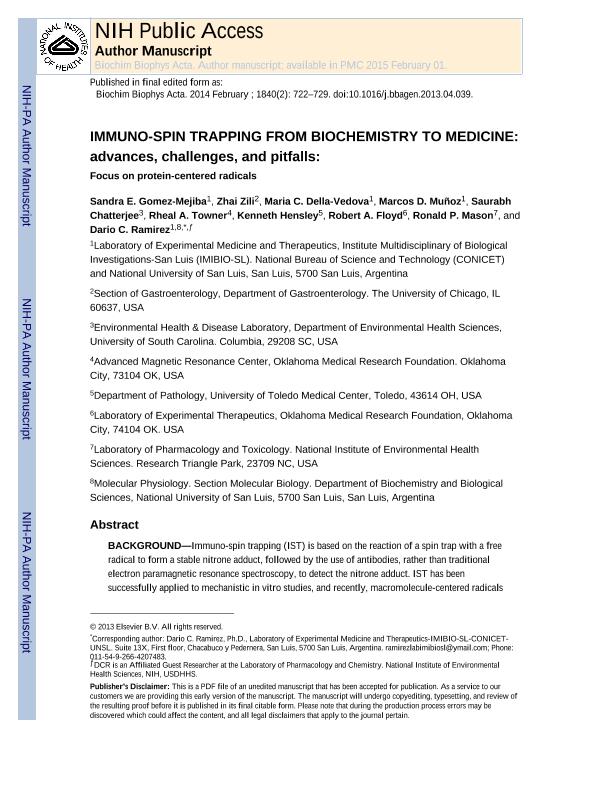Mostrar el registro sencillo del ítem
dc.contributor.author
Gomez-Mejiba, Sandra Esther

dc.contributor.author
Zhai, Zili
dc.contributor.author
Della Vedova, Maria Cecilia

dc.contributor.author
Muñoz, Marcos David

dc.contributor.author
Chatterjee, Saurabh
dc.contributor.author
Towner, Rheal A.
dc.contributor.author
Hensley, Kenneth
dc.contributor.author
Floyd, Robert A.
dc.contributor.author
Mason, Ronald P.
dc.contributor.author
Ramirez, Dario

dc.date.available
2017-03-31T23:18:53Z
dc.date.issued
2014-02
dc.identifier.citation
Gomez-Mejiba, Sandra Esther; Zhai, Zili; Della Vedova, Maria Cecilia; Muñoz, Marcos David; Chatterjee, Saurabh; et al.; Inmuno-spin trapping from biochemistry to medicine: advances, challenges, and pitfalls. Focus on protein-centered radicals; Elsevier Science; Biochimica et Biophysica Acta- General Subjects; 1840; 2; 2-2014; 722-729
dc.identifier.issn
0304-4165
dc.identifier.uri
http://hdl.handle.net/11336/14656
dc.description.abstract
Background: Immuno-spin trapping (IST) is based on the reaction of a spin trap with a free radical to form a stable nitrone adduct, followed by the use of antibodies, rather than traditional electron paramagnetic resonance spectroscopy, to detect the nitrone adduct. IST has been successfully applied to mechanistic in vitro studies, and recently, macromolecule-centered radicals have been detected in models of drug-induced agranulocytosis, hepatotoxicity, cardiotoxicity, and ischemia/reperfusion, as well as in models of neurological, metabolic and immunological diseases. Scope of the review: To critically evaluate advances, challenges, and pitfalls as well as the scientific opportunities of IST as applied to the study of protein-centered free radicals generated in stressed organelles, cells, tissues and animal models of disease and exposure. Major conclusions: Because the spin trap has to be present at high enough concentrations in the microenvironment where the radical is formed, the possible effects of the spin trap on gene expression, metabolism and cell physiology have to be considered in the use of IST and in the interpretation of results. These factors have not yet been thoroughly dealt with in the literature. General significance: The identification of radicalized proteins during cell/tissue response to stressors will help define their role in the complex cellular response to stressors and pathogenesis; however, the fidelity of spin trapping/immuno-detection and the effects of the spin trap on the biological system should be considered.
dc.format
application/pdf
dc.language.iso
eng
dc.publisher
Elsevier Science

dc.rights
info:eu-repo/semantics/openAccess
dc.rights.uri
https://creativecommons.org/licenses/by-nc-nd/2.5/ar/
dc.subject
ANTI-DMPO
dc.subject
DISEASE/EXPOSURE MODEL
dc.subject
IMMUNO-SPIN TRAPPING
dc.subject
PROTEIN RADICAL
dc.subject
REACTIVE CHEMICAL SPECIES
dc.subject
SPIN TRAP
dc.subject.classification
Medicina Forense

dc.subject.classification
Otras Ciencias Médicas

dc.subject.classification
CIENCIAS MÉDICAS Y DE LA SALUD

dc.title
Inmuno-spin trapping from biochemistry to medicine: advances, challenges, and pitfalls. Focus on protein-centered radicals
dc.type
info:eu-repo/semantics/article
dc.type
info:ar-repo/semantics/artículo
dc.type
info:eu-repo/semantics/publishedVersion
dc.date.updated
2017-03-30T17:43:50Z
dc.journal.volume
1840
dc.journal.number
2
dc.journal.pagination
722-729
dc.journal.pais
Países Bajos

dc.journal.ciudad
Ámsterdam
dc.description.fil
Fil: Gomez-Mejiba, Sandra Esther. Consejo Nacional de Investigaciones Científicas y Técnicas. Centro Científico Tecnológico San Luis. Instituto Multidisciplinario de Investigaciones Biológicas de San Luis; Argentina. Universidad Nacional de San Luis; Argentina
dc.description.fil
Fil: Zhai, Zili. University Of Chicago; Estados Unidos
dc.description.fil
Fil: Della Vedova, Maria Cecilia. Consejo Nacional de Investigaciones Científicas y Técnicas. Centro Científico Tecnológico San Luis. Instituto Multidisciplinario de Investigaciones Biológicas de San Luis; Argentina. Universidad Nacional de San Luis; Argentina
dc.description.fil
Fil: Muñoz, Marcos David. Consejo Nacional de Investigaciones Científicas y Técnicas. Centro Científico Tecnológico San Luis. Instituto Multidisciplinario de Investigaciones Biológicas de San Luis; Argentina. Universidad Nacional de San Luis; Argentina
dc.description.fil
Fil: Chatterjee, Saurabh. University of South Carolina; Estados Unidos
dc.description.fil
Fil: Towner, Rheal A.. Oklahoma Medical Research Foundation; Estados Unidos
dc.description.fil
Fil: Hensley, Kenneth. University of Toledo; Estados Unidos
dc.description.fil
Fil: Floyd, Robert A.. Oklahoma Medical Research Foundation; Estados Unidos
dc.description.fil
Fil: Mason, Ronald P.. National Institute of Environmental Health Sciences; Estados Unidos
dc.description.fil
Fil: Ramirez, Dario. Consejo Nacional de Investigaciones Científicas y Técnicas. Centro Científico Tecnológico San Luis. Instituto Multidisciplinario de Investigaciones Biológicas de San Luis; Argentina. Universidad Nacional de San Luis. Facultad de Química, Bioquímica y Farmacia. Departamento de Bioquímica y Ciencias Biológicas. Area de Biología Molecular; Argentina
dc.journal.title
Biochimica et Biophysica Acta- General Subjects

dc.relation.alternativeid
info:eu-repo/semantics/altIdentifier/url/http://www.sciencedirect.com/science/article/pii/S0304416513001943
dc.relation.alternativeid
info:eu-repo/semantics/altIdentifier/doi/http://dx.doi.org/10.1016/j.bbagen.2013.04.039
dc.relation.alternativeid
info:eu-repo/semantics/altIdentifier/url/https://www.ncbi.nlm.nih.gov/pmc/articles/PMC4078024/
Archivos asociados
